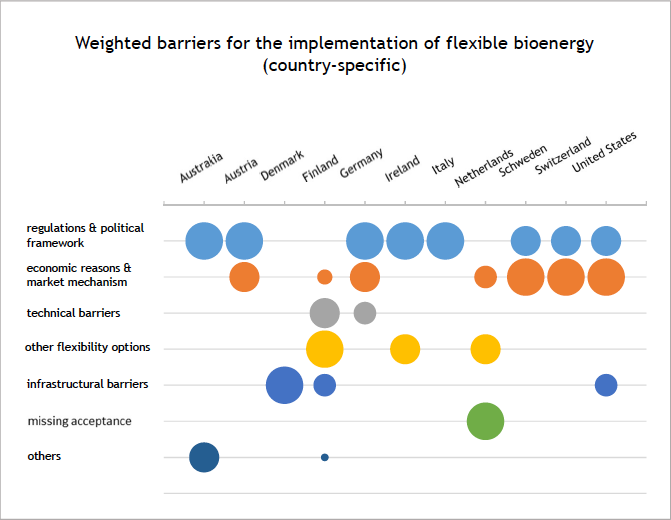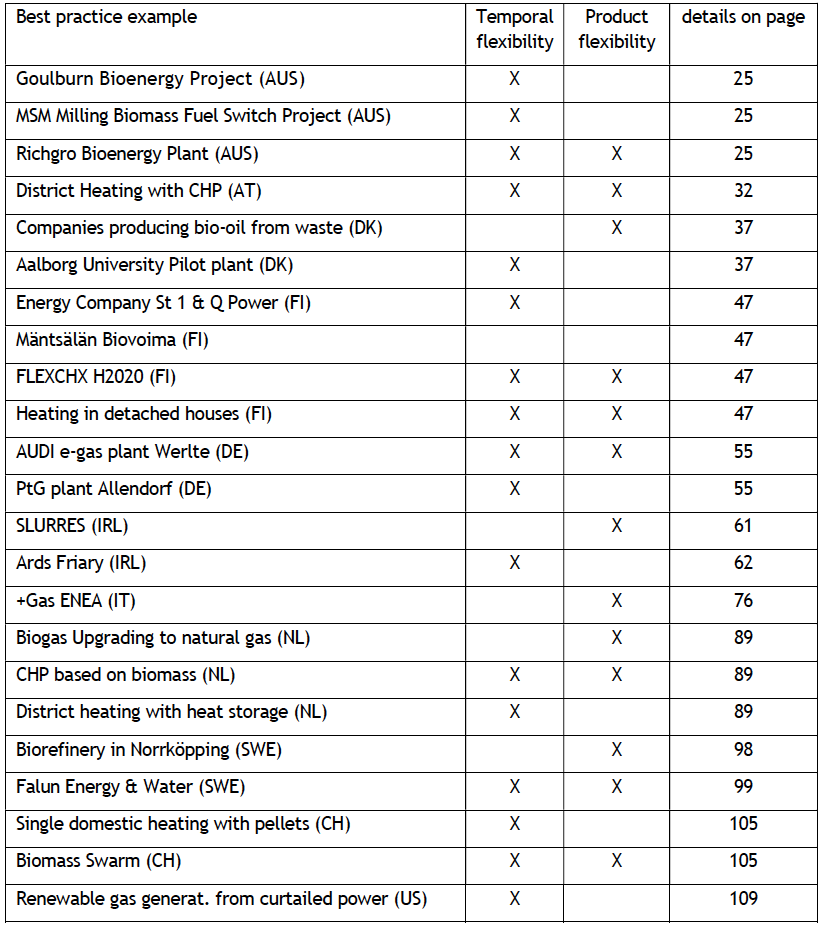New Publication – Expectation and implementation of flexible bioenergy in different countries
Flexible bioenergy is a bioenergy system that can provide multiple services and benefits to the energy system under varying operating conditions and/or loads. The relevance of flexibility will increase with the expected increase of varying renewable energies in the energy system. To unlock the manifold potentials of flexible bioenergy for future energy supply appropriate policy and market development is required. The implementation of flexible bioenergy is in its infancy and the broad range of secondary benefits that bioenergy can offer is currently not very much understood yet.
This report, produced by IEA Bioenergy Task 44 (Flexible Bioenergy and System Integration), gives an overview of the status, approaches and expectations of flexible bioenergy in 11 different countries, thereby also considering drivers and barriers. The countries are: Australia, Austria, Denmark, Finland, Germany, Ireland, Italy, Netherlands, Sweden, Switzerland and the United States of America.
Full report available here: IEA Task 44 report- Expectation and implementation of flexible bioenergy in different countries_update
The conclusions of the report were also presented in a webinar on 18 March 2021: https://www.ieabioenergy.com/wp-content/uploads/2021/03/IEA-webinar-20210311_daniela.pdf
Short summary:
According to the understanding of IEA Bioenergy Task 44 the definition of flexible bioenergy and system integration covers different dimensions of flexibility, including temporal flexibility, flexibility in the use of bioenergy, operational flexibility and end-product flexibility. The following definition is proposed:
Flexible bioenergy is defined as a bioenergy system than can provide multiple services and benefits to the energy system under varying operating conditions and/or loads. Examples of flexible
bioenergy include technologies and concepts providing grid stability for a power system with large amounts of variable wind and solar energy; dispatchable production of energy and other products according to market demand; integrated poly-generation systems combining the production of heat, power, fuels and/or chemicals; long-term storage options such as biofuels and biochemicals; or ancillary services to support system reliability.
There are flexible bioenergy processes in place globally. However, to realize the potential of flexible bioenergy for future energy supply appropriate policy and market development is required. The implementation of flexible bioenergy is in its infancy and the broad range of secondary benefits that bioenergy can offer is currently not very much understood yet – and additionally also the potentials are often described for certain energy sectors (i.e. electricity) or for certain types of flexibility.
The leading questions posed to the surveyed countries are:
- What is the status / state of the art of flexible bioenergy in the country?
- What are the bottlenecks (technological, economic, and systemic) that limit the flexibility of bioenergy?
- What type of market and policy measures are needed to support successful introduction of flexible bioenergy solutions to the energy system?
Some conclusions:
The actual role of bioenergy in the different surveyed countries strongly varies between sectors and countries, from only some percent up to more than 30% of the final energy demand. The heating and cooling sector is of major relevance today, and the expectation of varying renewable energies in the electricity sector leads to additional demand for flexibility. The power sector has a major impact in the perception of energy transition. While most of the countries are still in the decision making for climate neutral energy provision systems towards 2050 at the latest, the consideration of flexible bioenergy is still in an early stage.
Dedicated chances for flexible bioenergy are seen in the substitution of fossil fuels, in support of the energy transition providing flexible electricity, and also in different energy system services such as biofuels provision, renewable heat implementation as well as carbon capture and utilisation options and the reduction of grid operation costs. Even though all surveyed countries are OECD members, the status, policy frame and examples are heterogeneous and give different priorities to short term flexible bioenergy and multiproduct systems and longer-term flexibility services as well. Thus, even under the consideration of the phase of system transformation towards fluctuating renewables, we still see different expectations between the countries.
The introduction of variable renewable energies in the electricity sector increases the demand for flexibility – which is stated by different countries as an interesting new operation case, especially for biomass-based CHP units. In parallel, policy framework and regulation support an increased use of bioenergy. Here the political framework and regulation support the intake of bioenergy in the system, which might increase the interest in multi-product systems.
The main driver indicated for bioenergy and especially flexible bioenergy is to substitute fossil fuels and reach carbon neutrality. Bioenergy is expected to be flexible, sustainable and available in different sectors, which is in line with the characteristics of bioenergy. But a lack of regulation and insufficient political framework along with market barriers become prominent. These barriers could originate in the diverse implementation possibilities of bioenergy. Analysing the barriers also indicates that certain stakeholders such as policy makers and the energy sector require more information. In this field research institutions can be supportive and provide information on technologies, costs and energy system related aspects.
To introduce flexible bioenergy there is no blue print at the table. However, most of the countries mentioned best practice examples. As a first area of action a better promotion of best practices is proposed, as there is a wide variety of options to use biomass in different sectors and analysis of their replication potential. The report includes a number of best practice examples (see list below), which will also be published separately on https://task44.ieabioenergy.com/best-practices/ and regularly updated to keep track of recent developments.
Additionally, the countries see the need to encourage demonstration in pilot plants, which requires support by renewable energy research, implementation actions but also from an economic point of view. Technological aspects did not seem to be a major challenge, but rather the economic feasible integration of the technologies in the overall energy system. Therefore, a stronger link is proposed between flexible bioenergy and other options for flexibility, such as demand side management, energy storage, power-to-X and also green hydrogen.




